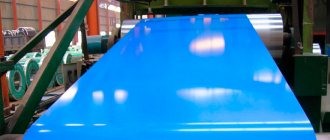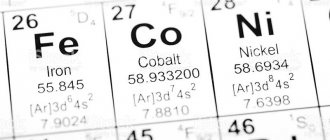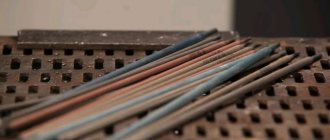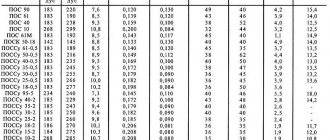Polymer coatings are used to protect metal parts from corrosion and give them a decorative appearance. A special type of polymer materials are anti-friction coatings, which not only prevent wear of parts, but also act as a lubricant.
Polymer coatings are intended for treating metal surfaces to protect against corrosion and give a decorative appearance.
The polymer coating can be polyester, polyvinylidene fluoride (PVDF), plastisol, pural, etc.
Let us consider these materials, their areas of application and application technologies in more detail.
Polyester
Polyester (polyester) is the most popular polymer used as a coating. It is characterized by high resistance to UV radiation, excellent anti-corrosion properties, and elasticity (easily moldable).
The polyester coating can withstand almost any temperature - both low and high.
Compared to other types of polymers, polyester is the most affordable.
The not very outstanding strength characteristics of the material are compensated by additional processing with quartz sand. However, the cost of applying the coating increases.
Transportation of products with a polyester-quartz protective layer presents certain difficulties, since sand can damage adjacent surfaces.
PVDF coating
Polyvinylidene fluoride (PVDF) is used to protect metals not much less frequently than polyester. This polymer consists of polyvinyl chloride (80%) and acrylic (20%).
PVDF forms a shiny, fade-resistant layer on parts, so it is often used as a decorative coating. This material can give the surface a gloss, metallic effect, copper or silver tint.
Polyvinylidene fluoride is resistant to mechanical stress and has the longest service life among all polymers. PVDF is used to treat metal surfaces that are exposed to aggressive environments.
Plastisol
Plastisol, like PVDF coating, has excellent decorative properties. In terms of cost, it is the most expensive, but at the same time it has the best resistance to mechanical damage.
Plastisol is applied in a thick layer (up to 200 microns) and is used to create textured coatings, embossed surfaces and stamped designs.
This material perfectly protects parts from moisture and corrosion, but under the influence of very high temperatures (over +80 ° C) and direct UV radiation it can lose its properties. That is why it is not recommended to use it in southern latitudes (as a last resort, you can use light-colored plastisol with maximum reflective ability).
What else to consider when choosing corrugated sheets?
When choosing corrugated sheeting with a polymer coating, it is also worth considering some other parameters, namely:
- material type . For the construction of internal partitions and cladding of buildings, wall corrugated sheeting (C) with a profile height of 8-35 mm is used. Roofing corrugated sheeting (H) is used in the construction of roofs, fences, and in the construction of non-residential buildings (hangar, garage, etc.), the profile height is more than 44 mm, it is a rigid and durable material. Load-bearing corrugated sheeting (NS) is a universal material that is suitable both for organizing the roof and for the construction of structures or for their finishing;
- The height of the wave affects the strength of the sheet, and the higher the height, the higher the strength. This parameter is indicated in the marking, for example, C8 is a wall profile with a wave height of 8 mm;
- size . The width of corrugated sheets ranges from 113-120 cm, length - 0.3-12 m. The choice depends on the size and geometry of the object that needs to be built;
- surface quality . The polymer coating must be free of scratches, dents and other defects; the sheets themselves should not have burrs at the edges;
- guarantee . If a manufacturer claims that the durability of its products is 20 years, and gives a guarantee for 6 months, then this should alert you. It is best to purchase profiled sheets directly from the manufacturer or from its official dealers. Give preference to large ones class=”aligncenter” width=”800″ height=”484″[/img]
In conclusion, we note that when choosing corrugated sheeting for a fence, it is a good idea to pay attention to the double-sided material - a polymer coating is applied to it on both sides, which ensures maximum aesthetics and durability.
The article was written for the site.
Pural
Pural is made on the basis of polyurethane and modified polyamide. The pural coating has a silky-matte surface, high heat resistance and resistance to sudden temperature changes.
This material does not fade and is not destroyed under the influence of chemically aggressive environments. Pural is not as resistant to plastic deformation as plastisol, and is more expensive than polyester, but in terms of price-quality ratio it is the best option of all those presented above.
Pural coatings are most widespread in the production of roofing elements made of galvanized metal. Steel treated with pural acquires a beautiful appearance, high anti-corrosion characteristics and resistance to UV radiation.
Polymer antifriction coatings
A special type of polymer protective materials are antifriction solid lubricant coatings. Outwardly, they are similar to paints, but the pigment in their composition is replaced by highly dispersed particles of solid lubricants: molybdenum disulfide, graphite, polytetrafluoroethylene, etc.
Solid lubricants are evenly distributed in a polymer binder: epoxy, titanate, polyurethane, acrylic, phenolic and other resins.
The demand for antifriction solid lubricant coatings is due to their excellent performance characteristics: high load-bearing capacity, wide range of operating temperatures, extreme pressure and anti-corrosion properties.
Unlike conventional polymer coatings, antifriction coatings can withstand prolonged exposure to chemically aggressive environments and extreme loads. At the same time, they perform not only a protective, but also a lubricating function, which also benefits them from polymers.
An example of such materials is domestic MODENGY coatings. They are used in a wide variety of industrial and automotive applications.
Typical components for using coatings are medium and heavily loaded bearings, guides, gears, internal combustion engine parts (piston skirts, throttle valves, etc.), threaded connections and other friction pairs made of various materials (metals, rubbers, plastics).
MODENGY anti-friction solid lubricant coatings are applied once for the entire service life of the parts, which makes it possible to completely eliminate the need for oils and greases for further maintenance.
It all starts with galvanization
Protection of metal tiles from corrosion is always multi-component. First, the steel is galvanized, then passivated for better fixation of zinc and additional protection, primed, and only then a polymer coating is applied. This protective “pie” allows even the cheapest types of metal tiles to last at least 10-15 years before the first spots of corrosion appear.
Consequently, the durability of the roofing material is affected not only by the type of metal tile coating, but also by the characteristics of the zinc layer. Moreover, this influence is very strong: two types of steel may have an identical polymer protective layer, but the service life may differ by 1.5-2 times. This is due to different densities of galvanizing or, more simply, with the consumption of zinc per 1 m2 of metal.
Depending on the thickness of the zinc coating of the metal tile, it can be divided into four classes:
- First class with a galvanizing density of 275 g/m2 or more. This is the European standard for roofing materials.
- Second class with a zinc layer density of 180-275 g/m2. Steel with this coating is also of quite high quality.
- Third class with a zinc coating density of 142.5-180 g/m2. Metal tiles with this type of coating perform well in gentle conditions, but in regions with difficult climates they begin to rust much faster than first-class material.
- Fourth class with a galvanizing density of 100-142.5 g/m2. A very low-quality but cheap material that can only be used on temporary buildings with a limited service life.
European companies also produce metal tiles with a coating with a density of up to 350 g/m2. This material is expensive, designed for particularly difficult conditions, so it is rare in Russia and is not used for private construction.
Obviously, all other things being equal, metal tiles with a density of 275 g/m2 will last much longer than zinc-coated material with a consumption of less than 142.5 g/m2. But such metal tiles also cost significantly more. The material of the second and third classes is a compromise in this sense, and most often it is chosen for private houses.
Advantages and disadvantages of polymer coatings
Polymer coatings have both undeniable advantages and obvious disadvantages.
The advantages of polymers include:
- Aesthetics
- Impenetrability
- Relative heat resistance
- Electrical insulating properties
- Water resistance
- Environmental friendliness
- High adhesion
- Large selection of colors
However, along with the positive aspects, polymer coatings are not without disadvantages. The main one is the high cost of application, which consists of the cost of the polymer itself, auxiliary (priming) materials, special equipment, etc.
Another disadvantage of polymer coatings is the difficulty of removing them. They are quite resistant to chemicals, so the polymer layer cannot be removed with a solvent. The coating can only be removed using a special tool.
A significant disadvantage of polymers is the impossibility of applying them without special tools, which are available only to industrial enterprises or specialized specialists.
In addition, not all metals can be coated with polymer compositions, but only those that conduct electric current. This is due to a special method of applying polymers - by magnetic induction.
Production technology
Corrugated sheeting is a sheet of cold-rolled steel, onto which a protective coating is applied, and then a certain relief is given to it. This is very short. The final characteristics of the sheet depend on what kind of coating was used, its thickness and weight of other parameters.
The production process of polymer-coated corrugated sheets is as follows:
- applying a protective zinc coating to steel sheets;
- degreasing and drying;
- a primer, thanks to which the adhesion of galvanization and the polymer layer significantly increases;
- application of a polymer coating with a thickness of 25-200 microns . Typically, polymer protection is applied only to the front side of the sheet, and the back is covered with a layer of varnish, but in some cases both sides are protected with a coating. Such sheets are usually used to organize fences in order to provide it with high decorative qualities;
- final polymerization and strengthening of the protective layer in high-temperature chambers;
- rolling the sheet on a profile bending machine to give it a relief (wave or trapezoid, height 8-180 mm). In some industries, the sheet is given relief after galvanizing, and only then a polymer coating is applied.
As a rule, a powder coating method . A positive charge is passed through the metal, and a negative charge is given to the polymer powder. An electromagnetic field is created, and the powder is attracted to the metal, and polymerization occurs in the chambers under the influence of high temperatures. The liquid painting method is used less frequently, but it does not allow creating a uniform layer on the metal, resulting in reduced durability of the coating.
The quality of corrugated sheeting (and in particular polymer coating) depends on how responsibly the manufacturer approached the production of products. That’s why it’s so important to contact only trusted manufacturers and sellers.
Residents of the North-West region can recommend products. Among other things, the company offers polymer-coated corrugated sheets; the range can be found at https://treydmetall.ru/produktsija/listovoj-metalloprokat/profnastil-s-polimernyim-pokryitiem.











